Zapatistas: 20 years of reinventing revolution
- January 4, 2014
Land & Liberation
Democracy is forged from below, and peasants have been at the heart of many revolutions, emerging on decisive moments to define the course of history.
- Author
On December 25, I was supposed to register at the Centro Indígena de Capacitación Integral (CIDECI) for the second round of the Escuelita Zapatista, but given that the flights from Mexico City to Tuxtla were full and the highway from Villahermosa to San Cristóbal was damaged by a flood, I couldn’t make it to San Cristóbal until late at night. The next morning I arrived at the CIDECI.
The people there told me to wait until they were able to ask someone if I could still take the course even if I missed the first day. They offered me to have lunch with the guardian@s, the young Zapatistas who are in charge of receiving and accompanying the students of the Escuelita. There were about forty in the line waiting for food, and the oldest must have been at most eighteen years old. Except for three girls and the women serving food, all of them were male.
The lunch was composed of beans, pasta, some vegetables, tortillas, coffee and a piece of sweet bread. I felt lucky since I was expecting only beans and tortillas, following the accounts of a Greek friend who spend some time in the several caracoles and Zapatista communities and who returned skeleton-thin months after. I sat at a table at CIDECI’s cafeteria with some guardian@s. Some of them started speaking an indigenous language, maybe Tsotsil. Two of them spoke among themselves in Spanish and I was able to listen to their conversation:
— “My mom is in the US, my dad is in the US, my brother is in the US. The next year I will go there with them.”
— “Why do you want to go there?”
— “Because that will allow me to earn enough money to have a house, a family.”
— “And why didn’t you go there this year?”
— “Because I am seventeen years old. If they catch you, they put you in a prison for kids. They think you don’t have parents and things like that. They lock you up for months, maybe years. If they catch you and you are eighteen years old, they release you in a week”
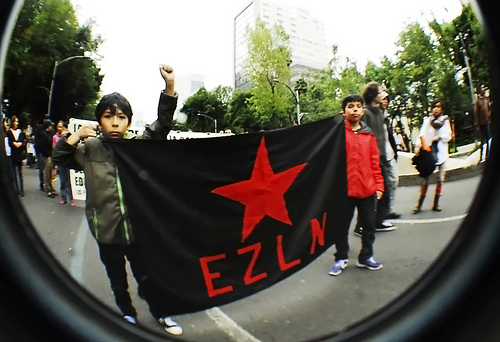 I started doing the math. If these kids are seventeen years old, it means they were born three years after the Zapatista uprising of 1994 and they were seven when the caracoles were created. They may be the first generation truly raised in the autonomous Zapatista territories. Their worldviews must be very different from those of other Mexican kids. They have the difficult task to instruct people older than them, coming from all corners in the world, about such a complicated matter as autonomy. But they don’t seem to panic. They don’t seem to share the pathetic reverence that people of modest education generally have for the supposedly better instructed.
I started doing the math. If these kids are seventeen years old, it means they were born three years after the Zapatista uprising of 1994 and they were seven when the caracoles were created. They may be the first generation truly raised in the autonomous Zapatista territories. Their worldviews must be very different from those of other Mexican kids. They have the difficult task to instruct people older than them, coming from all corners in the world, about such a complicated matter as autonomy. But they don’t seem to panic. They don’t seem to share the pathetic reverence that people of modest education generally have for the supposedly better instructed.
This made me think of one of the main ideas of Paulo Freire on education, in which he states that education requires solidarity between the act of teaching and being taught. I thought about the incredible life experience I was just going to begin and also about the enormous impact it must have on these kids to be exposed to people from many different countries and Mexican regions. After living isolated in their poor villages hidden in the hills of Chiapas, the world was now coming to them. Then, someone with a cell phone came, hung up the phone and told me: “I’m sorry, you can’t take the courses. You can’t stay.” Suddenly Freire, the villages and the hills disappeared. It took me days to digest the frustration: “They have to be strict, they are an army after all,” I thought.
They invited me to the celebration of the Zapatista anniversary and offered to register me for the next round of the Escuelita. I refused this last offer because I had a plane to catch. Obviously, that refusal changed completely the idea of writing a journalistic type of article about the Escuelita. Following an advice I took from a fieldwork seminar I tried to turn the problem into an opportunity and opt for the plan B: installing myself in a cyber café in San Cristóbal for a couple of days, to focus on the anniversary and polish some reflections that I started when I was still a Bachelor student. This strategy allowed me to order my thoughts around a question that has been puzzling me for some time: why does Zapatismo seem even more up-to-date today than 20 years ago?
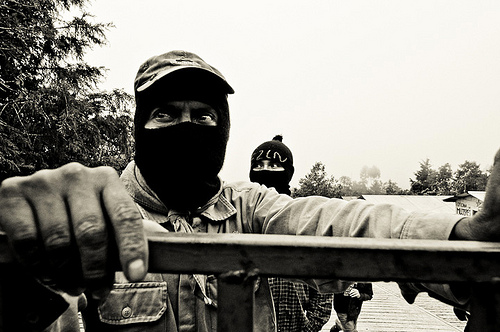 After the 1994 Uprising
After the 1994 Uprising
I promised myself I would not write a text of propaganda, and I do not want to idealize the Zapatistas, but it is hard not to feel empathy for their outcry for human decency. Twenty years have passed since the Zapatistas declared war on the Mexican state for having signed the North American Free Trade Agreement (NAFTA), for closing definitively the agrarian reform by modifying article 27 of the Constitution, and for the lack of institutions to guarantee fair elections in Mexico. The first day of 1994, the EZLN fought and occupied the municipalities of San Cristóbal, Ocosingo, las Margaritas , Altamirano, Chanal, Huixtán and Oxchuc in Chiapas. The official death toll of the armed struggle was 56 casualties, most of them young indigenous rebels. The EZLN also kidnapped the former governor of Chiapas, Absalón Castellanos Domínguez, together with his wife and his brother. The hostages were released later without any harm inflicted on them.
The Zapatistas were expecting their armed struggle to activate other guerrilla “sleeper cells” throughout in Mexico. They thought that peasant organizations and unions would follow and rise up in arms, starting a revolutionary war against the government. Indeed, the call resonated in many places of Mexico’s geography and other belligerent groups, unions and peasant and social organizations declared their solidarity with the EZLN. But it quickly became clear it was not enough to overthrow the authoritarian PRI regime; that victory through military means would not be achieved. The revolution they expected didn’t occur and many diagnosed the total failure of the Zapatistas.
Instead, the initial uprising triggered an erratic flow of events. The brief period of armed struggle was followed by a phase of tense and complicated peace talks which culminated in the agreements of San Andrés; several repressive acts perpetrated by paramilitary forces against Zapatistas sympathizers, including the shameful killing of 45 unarmed indigenous women and children praying in a church in the village of Actéal; several referendums to include Mexican and international civil society in their decisions; the mockery of including indigenous rights in the Mexican Constitution; the assassination of human rights’ activist Digna Ochoa who was defending the Zapatista political prisoners (the Distrito Federal attorney stated she shot herself with a gun, an account no one believes because the bullet came from the left side of her head — Digna was right handed); many mobilizations (some of them nationwide) followed by long periods of silence when the EZLN returned to the hills (silence became an event as well and served to intrigue the Mexican government about the next actions of the Zapatistas).
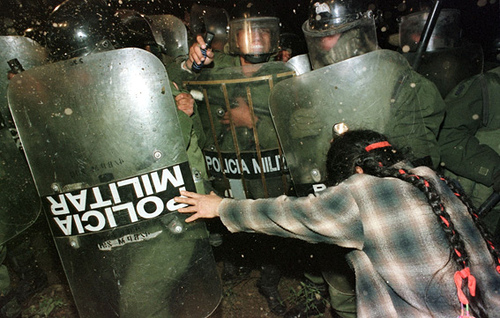 In the long run, there are many reasons why the eventful path of the Zapatistas may be even more surprising than a conventional revolution, like those of the 20th century. Many of the things that happened in these twenty years in Chiapas became crucial events for the creation of the autonomous Zapatista governments, the so-called Juntas de Buen Gobierno; for justice and democracy in Mexico; for the advancement of indigenous rights in Latin America; and for the rise of the global anti-capitalist movement. It is still surprising that indigenous people from Chiapas suddenly rebelled after centuries of quietly suffering appalling conditions of poverty, oppression and abandonment, and it is not very clear yet exactly how it happened. It is not very clear either how the Zapatistas, many of whom carried little more than toy guns carved out of wood, suddenly reached the very epicenter of this global anti-capitalist struggle.
In the long run, there are many reasons why the eventful path of the Zapatistas may be even more surprising than a conventional revolution, like those of the 20th century. Many of the things that happened in these twenty years in Chiapas became crucial events for the creation of the autonomous Zapatista governments, the so-called Juntas de Buen Gobierno; for justice and democracy in Mexico; for the advancement of indigenous rights in Latin America; and for the rise of the global anti-capitalist movement. It is still surprising that indigenous people from Chiapas suddenly rebelled after centuries of quietly suffering appalling conditions of poverty, oppression and abandonment, and it is not very clear yet exactly how it happened. It is not very clear either how the Zapatistas, many of whom carried little more than toy guns carved out of wood, suddenly reached the very epicenter of this global anti-capitalist struggle.
Perhaps, as Eric Hobsbawm thought, the 20th century was a short one, which ended in 1989 with the fall of the Berlin Wall. What happened in Chiapas in 1994 was already outside of the Cold War logic. Perhaps it pulled out of their mourning many of those who felt like orphans when the Soviet Union collapsed. Maybe the radical left was ready for the call (any call) and the Zapatistas were lucky enough to revolt at the exact right historic moment. Perhaps the call was not answered exactly as they thought, but for some reason and without doubt, the Zapatista uprising reached many hearts and resonated in many corners throughout the world.
Some insights from the Zapatista struggle suggest that a deep understanding of the historical transformations taking place in Mexico and the world, rather than pure luck, had much more to do with the formation of a movement that for 20 years has provided new ideas to the radical left at many different levels. For example, the initial rebellion was a surprising success mainly because the Zapatistas strategically chose an optimal symbolic date, taking the PRI government completely by surprise. On January 1, 1994 NAFTA came into force, opening large segments of the Mexican, American and Canadian economies to free trade. The agreement signified the culminating of the neoliberal transformation process and a major step toward the liberal modernity offered by the Salinas administration. For these reasons the eyes of the world were fixed upon the region. The Zapatistas ruined Salinas’ party and literally transformed history. The next day, instead of covering Mexico’s “major leap forward” toward liberal modernity, journalists wrote about indigenous peasants being repressed by an authoritarian neoliberal regime.
Catching a Glimpse of Chiapas
I decide to take a quick glance at Chiapas in order to gather ideas and to answer my question. I head towards Yaxchilán, the amazing archaeological site at the Usumacinta River, which constitutes the Mexico-Guatemala border. To go there, you have to take several means of transport in order to traverse the hills of Chiapas deep into the Lacandon jungle. First to Palenque, then to Ococingo, then to Frontera Corozal, and then a 5km boat ride in order to get to the hidden Mayan city where small monkeys roar as loud as huge orangutans.
“Are you ready for the turns in the road?” asks the driver, just before putting his hands on the wheel and hitting the road. Along the eternal curves I see many Baptist churches of several denominations; people carrying lumber on their backs and half-naked children trying to sell fruit. Complicated geography, organizational networks established by churches and a strong grievance are all elements that help one understand why Chiapas was the perfect place to start a rebellion and nurture a guerrilla organization. The Zapatistas took advantage of the hills and networks, and effectively channeled the local grievances.
On my way back I hear a passenger talking with the driver:
— “Do you know what is the main product of these ejidos?”
— “What?”
— “Kids.”
Answers the passenger as we cross a valley full of children. Some of them are not even three years old and they are let loose on the highway. Some of them cross running without even looking when cars are coming, some are already carrying wood on their backs with a rope sustained from their forehead. Some are carrying their younger brothers. Others gather on the multiple road bumps, uselessly trying to sell fruits. One was even sitting on the highway staring at the horizon, not in the middle of the highway but not close to the edge either.
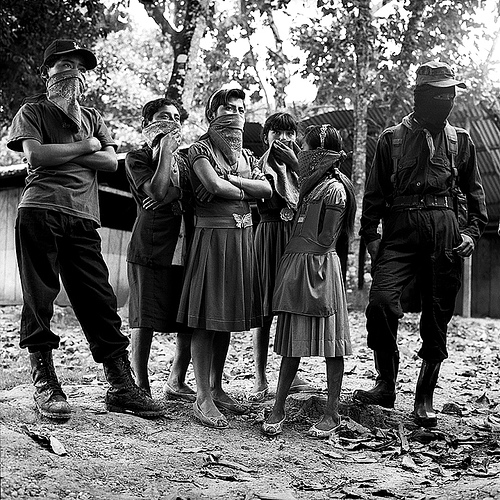 But nothing will convince Chiapanese drivers that speeding is dangerous. Children, animals, heavy rain, fog, damaged roads, not even the intuition that other reckless drivers may be around, they just step on the gas until they reach their destination, trying to make as many trips as possible in order to make more money. It seems the drivers’ recklessness increases as buses become cheaper. My heart almost stopped when we tried to pass a trailer on a curve. Luckily no other car appeared in front of us, and it seemed I was the only person worried.
But nothing will convince Chiapanese drivers that speeding is dangerous. Children, animals, heavy rain, fog, damaged roads, not even the intuition that other reckless drivers may be around, they just step on the gas until they reach their destination, trying to make as many trips as possible in order to make more money. It seems the drivers’ recklessness increases as buses become cheaper. My heart almost stopped when we tried to pass a trailer on a curve. Luckily no other car appeared in front of us, and it seemed I was the only person worried.
It is December 31, a foggy day, and I’m heading towards one caracol for the anniversary of the Zapatista uprising. I arrive at Altamirano, where many people died 20 years ago when the EZLN took control of the municipality. I jump on the back of a pickup truck with a group of five Chilangos and two Tzeltales from the area. One of the two Tzeltales is sullen drunk. The other is drinking a beer. “¡Hola compa! ¡Hola compa!” They greet us and I start a conversation with the least drunk one. He excuses himself for drinking and he says he is Zapatista. He tells me he usually does not drink, but since it is New Years’ eve, he decided to cheer up a little.
The man tells me he has seen a lot of places in Mexico, working in agriculture. He is one of the millions of internal migrants who leave the poor regions of Southern Mexico and head to the North. He was picking tomatoes in Sinaloa but he didn’t earn enough money, only 120 pesos per day (about $10 USD). He wanted to go to the US but he knew it was very dangerous so he missed his chance to cross the border when he was in Sinaloa. He regrets it now.
The drunkest guy starts laughing and accuses the other of not being a Zapatista. “He is not a Zapatista, as he said, he is a Priista!” It starts raining and we are freezing on the pickup bed. The paved road ended some minutes ago and we have to hold tight in order not to fall. Finally, the fog and the rain reveal a wall painting of Emiliano Zapata and a sign: “Está usted en territorio Zapatista en rebeldía. Aquí manda el pueblo y el gobierno obedece.” You are in Zapatista rebel territory. Here the people govern and the government obeys.
We gather in front of the fence where our names, nationalities and organizations are taken by the gatekeeper. The thinnest dog I’ve ever seen slips through the gate, as a recall that we are in one of the poorest regions in Mexico. We are granted access and they take us to the chair of the junta, a humble one-piece brick building with amazing revolutionary murals. They welcome and assign us a place to sleep, a long and empty building where about fifty people can sleep on the floor.
I leave my bag and head towards the epicenter of all action: the basketball court, where a wild game is taking place between two teams of Tzeltal women, followed by a match between Tzeltales and some Italian volunteers who were easily wiped out by the local team. The megaphone gives a message, something like this: “Good afternoon dear compa visitors, this message is to inform you that coffee is ready and therefore you can already go there to drink a cup.” A huge line of coffee seekers is formed. They are quickly served by two compas who prepared the coffee in a huge pot heated with wood.
 I sit on a bench close to the court. A music band starts to play a long list of cumbias, corridos and salsas. Drinking coffee I start thinking of the Tzeltal I met at the pickup truck. I doubt he was a Zapatista, given the strong measures against alcohol consumption that the juntas have taken. These measures were taken, according to a friend I found at the caracol, “because drunk men used to beat their wives after parties.” But restraining from alcohol also seems to be a measure to become productive, a “must” if Zapatistas are in the quest for autonomy. All the great ethnographies of Mexican peasants (Erich Fromm, Oscar Lewis) treat alcoholism as an essential problem for the campesinos’ well-being. And here the Zapatistas are surrounded by Priista communities receiving aid from the government (“los hermanos partidistas“, the partisan friends, as they are amicably referred to by the Zapatistas).
I sit on a bench close to the court. A music band starts to play a long list of cumbias, corridos and salsas. Drinking coffee I start thinking of the Tzeltal I met at the pickup truck. I doubt he was a Zapatista, given the strong measures against alcohol consumption that the juntas have taken. These measures were taken, according to a friend I found at the caracol, “because drunk men used to beat their wives after parties.” But restraining from alcohol also seems to be a measure to become productive, a “must” if Zapatistas are in the quest for autonomy. All the great ethnographies of Mexican peasants (Erich Fromm, Oscar Lewis) treat alcoholism as an essential problem for the campesinos’ well-being. And here the Zapatistas are surrounded by Priista communities receiving aid from the government (“los hermanos partidistas“, the partisan friends, as they are amicably referred to by the Zapatistas).
If the Zapatistas drink less, they can work harder, gather some resources and save themselves from becoming employees of the Priista communities or being forced to sell their land. There is some evidence suggesting that families receiving government benefits are turning lazy and less productive. As the Zapatistas have become hard workers, they are the ones accumulating the partidistas’ money by selling them maize, cattle or chicken.
Celebrating Zapatismo
This leads me directly to one possible answer for the question why Zapatismo seems so up-to-date today. Critics of the EZLN argue that the Zapatistas have lost a justification for their very existence because the government found effective means to deal with one of their main claims: to reduce poverty. But these critics forget that, although poverty reduction programs have become an essential component of the income of many disadvantaged Mexican families, they have also been used as a counter-insurgency tactic to dismantle collective identities and to strengthen the clientelistic power of the government over the communities.
These social programs (planes sociales) were partly aimed to “win the hearts and minds” of the local population, just as the American army tried to do in its wars in Vietnam, Iraq and Afghanistan. As if this were not enough, real poverty in Mexico is actually increasing. According to the Economic Commission for Latin America and the Caribbean (ECLAC), Mexico was the only case out of eleven Latin American countries in which poverty increased in recent years. Just last year, another one million Mexicans fell below the poverty line, joining the other half of the population that already lives in poverty.
Night has fallen together with rain. After songs and poems, now it’s time for the speeches. “Compas, compañeros y compañeras, compitas, compa anciano, compas visitantes, compañeros que nos acompañan.” The speech of the junta speaker cannot be more repetitive of the word “compa”. Nevertheless, it explains in a unique and touching way the motivation behind the Zapatista struggle. The man gives a great speech, better than anyone would ever expect considering how the educational system here has been abandoned by the Mexican government.
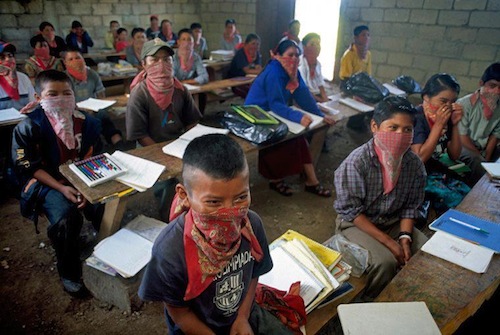 The rain is falling heavy when the speeches end. The band is playing its fastest cumbias. At this moment there are only two options: take shelter or join the frenetic dancers at the basketball court. I chose the latter, as did most of the people. I had heard the Zapatistas were tireless dancers and now I know is true. There are two Tzeltal girls dancing between themselves. They are soaking as if they just came out of a waterfall and couldn’t care less. I follow their example. Except for the basketball court, there is mud everywhere in the caracol. I was so happy I didn’t fall when I slipped on my way to the latrine, where I found evidence it had been used by city people. I remembered George Orwel’s words in Homage to Catalonia: “Dirt is something people make too much fuzz about,” and I agreed. I’m tired, so I went to sleep minutes after the midnight fireworks.
The rain is falling heavy when the speeches end. The band is playing its fastest cumbias. At this moment there are only two options: take shelter or join the frenetic dancers at the basketball court. I chose the latter, as did most of the people. I had heard the Zapatistas were tireless dancers and now I know is true. There are two Tzeltal girls dancing between themselves. They are soaking as if they just came out of a waterfall and couldn’t care less. I follow their example. Except for the basketball court, there is mud everywhere in the caracol. I was so happy I didn’t fall when I slipped on my way to the latrine, where I found evidence it had been used by city people. I remembered George Orwel’s words in Homage to Catalonia: “Dirt is something people make too much fuzz about,” and I agreed. I’m tired, so I went to sleep minutes after the midnight fireworks.
I forgot to bring a blanket or a sleeping bag and half of my clothes are wet. I’m wearing two thick socks on each foot, two blue jeans, a T-shirt, a flannel shirt, a sweater, a jacket and a towel. Still, I’m freezing. I remembered Orwell’s account on the Catalonia trenches again: “We were not fighting the fascists, we were fighting pneumonia.” On my left side there is a Tzeltal woman sleeping peacefully, covered only with her rebozo. I feel ridiculous shivering next to my inured neighbor.
It’s 5:30 am. They wake us up for civic duties around the flag. I skip the duties and sleep again. I wake up when I smell beef stew and coffee, feeling a little guilty. It’s around 8. This day the change of Junta will take place. They ask everyone to take a seat inside the auditorium. I got goosebumps when I saw the thirty or forty members of the outgoing junta entering the auditorium with their pasamontañas and paliacates. “Compas, compañeros, compañeras, etc…” the speaker starts again. They present everyone of the outgoing junta, who are giving back their command baton to the elder, who in turn will give it to the recently elected members of the junta, composed of men and women, more or less in equal numbers. Everyone is moved when a woman, wearing a pasamontaña and paliacate, receives the baton from the elder, and at the same time breastfeeds her newborn.
I start thinking on the up-to-date question again. Critics of the EZLN claim that the Zapatistas’ stance to remain outside of the political institutions is anachronistic. “Marcos’ mission has been accomplished,” is a comment I have heard in many after-dinner conversations in Mexico City. They claim that the Mexican “transition” to democracy left those who see the antagonistic struggle as a legitimate path to social change without arguments. But maybe it’s the Mexican institutions that sidelined democracy.
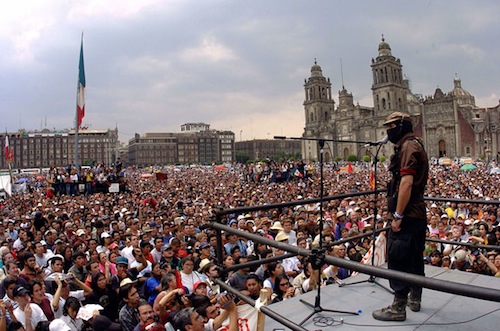 The critics fail to understand the huge importance that traditions have for the political organization of the indigenous communities. “The elder compas pass on the command baton because they are the ones who know, they represent wisdom and experience,” says the junta speaker. The critics also claim that Zapatismo lost its rationale after indigenous rights were included in the Mexican Constitution. They ignore the fact that the constitutional bill that was finally approved was radically different than the text agreed at San Andrés during the pace talks between the EZLN and the Comisión de Concordia y Pacificación (COCOPA). The Constitutional text was limited to the lowest extreme; it is impossible to derive secondary laws from it and therefore impossible to define mechanisms by which indigenous peoples will benefit from their natural resources, meaning that Subcomandante Marcos’ qualification of the reform as a “legislative mockery” was entirely correct.
The critics fail to understand the huge importance that traditions have for the political organization of the indigenous communities. “The elder compas pass on the command baton because they are the ones who know, they represent wisdom and experience,” says the junta speaker. The critics also claim that Zapatismo lost its rationale after indigenous rights were included in the Mexican Constitution. They ignore the fact that the constitutional bill that was finally approved was radically different than the text agreed at San Andrés during the pace talks between the EZLN and the Comisión de Concordia y Pacificación (COCOPA). The Constitutional text was limited to the lowest extreme; it is impossible to derive secondary laws from it and therefore impossible to define mechanisms by which indigenous peoples will benefit from their natural resources, meaning that Subcomandante Marcos’ qualification of the reform as a “legislative mockery” was entirely correct.
(Un)surprisingly, those politicians who argue that the EZLN is anachronistic today are the same politicians who spend millions to buy votes each election period. Rampant vote buying was one of the main features of the last 2012 elections (particularly in Chiapas and particularly by the ruling PRI, but by no means exclusively). The electoral process ended de facto when the Federal Electoral Institute exonerated the PRI from the “Monex” affair, a cynical vote buying act consisting in distributing electronic cards to buy food at a grocery store in exchange for votes for the PRI.
Learning the Hard Way
My trip started unpredictably and ended as such, just like the Zapatistas. There is a shortage of transport to San Cristóbal, but I am lucky enough to find a lift, on the trunk of a jeep van, but still a lift. On the trunk I think of what will follow for the Zapatistas now that they are moving away from the body of Mexico. But the PRI has returned to power both in Mexico and in Chiapas, so the Zapatistas may be cautious as the risk of a return of the paramilitaries — as during the time of Priista governor Roberto Albores — is real. The Zapatistas’ old enemies are in powerful positions, like the former Secretario de Gobernacion, Emilio Chuayfet, substituted a week after the Actéal massacre and whose responsibility in the killing is still unclear. He is the current Secretary of Education in the Peña Nieto administration.
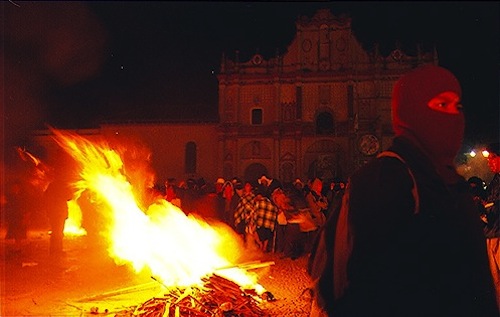 Mexico’s neoliberal elite continues to sell what is left of the country to foreign capital. Oil, the strongest emblem of Mexican nationalism has finally been grasped, just as happened with land tenure over twenty years ago. The Mexican electoral system, praised as one of the most effective and trustworthy during the late 1990s and early 2000s, suffered a major setback as the Federal Electoral Institute finds itself being substituted by an ambiguous institution whose performance remains to be seen. Thinking about elections leads me to my final thought regarding the up-to-date question: it was just after (and to a great extent in response to) the Zapatista uprising that the Mexican electoral and party systems advanced substantively in terms of inclusiveness, independence and trustworthiness.
Mexico’s neoliberal elite continues to sell what is left of the country to foreign capital. Oil, the strongest emblem of Mexican nationalism has finally been grasped, just as happened with land tenure over twenty years ago. The Mexican electoral system, praised as one of the most effective and trustworthy during the late 1990s and early 2000s, suffered a major setback as the Federal Electoral Institute finds itself being substituted by an ambiguous institution whose performance remains to be seen. Thinking about elections leads me to my final thought regarding the up-to-date question: it was just after (and to a great extent in response to) the Zapatista uprising that the Mexican electoral and party systems advanced substantively in terms of inclusiveness, independence and trustworthiness.
It seems that Mexicans only learn the hard way — that the relative leap forward of the 1996 political reforms, however incomplete, still remains almost unprecedented, perhaps with the exception of the 1977 reforms, which were also preceded by an armed struggle of peasants (the rebellion led by rural professors Lucio Cabañas and Genaro Vazquez in Guerrero). It seems there is little room for coincidence: democracy is forged from below, and peasants are central characters in any revolution, whether it takes place in France, China or Mexico. Millions of them. Coming out of the deep rural regions on decisive moments to define the course of history. A friend shared with me one of the questions he asked to his guardian once the Escuelita ended:
— “How many Zapatistas are there really?”
— “That can only be answered in one way: ¡Un chingo! A shitload!”
Source URL — https://roarmag.org/essays/zapatista-autonomy-reinventing-revolution/

